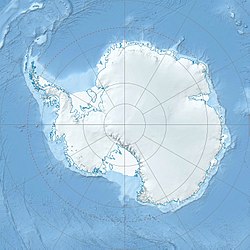Cape Crozier
| Cape Crozier | ||
 Photo of Cape Crozier and Mount Terror, by Herbert Ponting in 1911 during the Terra Nova Expedition made |
||
| Geographical location | ||
|
|
||
| Coordinates | 77 ° 31 ' S , 169 ° 24' O | |
| location | Ross Island ( Ross Archipelago , Antarctica ) | |
| Waters | Ross Sea | |
| Waters 2 | Ross Ice Shelf | |
 Map of Ross Island with Cape Crozier in ASPA 124 |
||
Cape Crozier is the easternmost point of Ross Island in Antarctica . The cape was discovered in 1841 during James Clark Ross ' expedition with the HMS Erebus and the HMS Terror and named after Francis Crozier , the captain of the HMS Terror . The extinct volcano Mount Terror rises directly on the cape to a height of 3230 meters, the edge of the Ross Ice Shelf (known at the time as the Barrier or Great Ice Barrier ) extends to the east.
First landing in 1902
The first landing at Cape Crozier happened on June 22, 1902 during Robert Falcon Scott's Discovery Expedition . A group from the RRS Discovery landed in a small boat in a stony bay a bit to the west of the cape. A mailbox was set up and marked so that messages could be taken from a later ship. Scott, Edward Wilson and Charles Royds climbed the slope to a vantage point from which they could see the surface of the Ross Ice Shelf and the large colony of emperor penguins that inhabit the pack ice around Cape Crozier. The biologist Wilson took a constant interest in this colony and later made two trips from the base in McMurdo Sound to examine the colony more closely, which he would visit again in 1911.
Terra Nova Expedition 1910–1913
Scott was seriously considering Cape Crozier as a base for his second Antarctic expedition. On the first voyage, the Discovery had frozen in McMurdo Sound for more than two years and narrowly escaped in February 1904, a circumstance that led to an expensive rescue operation and some shame for Scott. In the open sea off Cape Crozier there was no danger that the Terra Nova would freeze, but the unprotected location would have made it difficult to bring goods and personnel ashore, the coastal base would have been exposed to the harsh weather and the route to the surface of the ice shelf would have been problematic been. Scott decided to re-establish the base in McMurdo Sound, albeit further north (at Cape Evans ).
Winter journey 1911
Wilson research on a wanted to embryo of the emperor penguin continue and had to eggs in an early phase of nesting arrive, which meant that they are collected in the middle of the Antarctic winter had. In the zoology section of the scientific report published after the Discovery Expedition, he suggested a winter voyage on which the eggs could be obtained. This trip was undertaken with Scott's consent between June 27 and August 2, 1911 by Wilson, Apsley Cherry-Garrard, and Henry Robertson Bowers . In the darkness of winter and the extreme weather conditions, the journey proved slow and dangerous, but despite mishaps three eggs were collected. Ultimately, however, their scientific merit proved to be low.
Restricted area
Cape Crozier is now in an area that is only accessible to a limited extent; permission must be obtained. It is part of the Antarctic Specially Protected Area No. 124 (ASPA 124, Specially Protected Area of Antarctica No. 124), classified by the SCAR (Scientific Committee for Antarctic Research), originally designated Specially Protected Area No 6 (SPA 6) in 1966 . Cape Crozier is home to one of the largest Adelie penguin colonies in the world (approx. 150,000 breeding pairs), a smaller emperor penguin colony (approx. 600 breeding pairs) and one of the largest Skua colonies (approx. 1,000 breeding pairs). Some rare species of lichen also grow here .
literature
- Edward Wilson: Diary of the Discovery Expedition , Blandford Press 1966
- Scott's Last Expedition Vol. 1, Smith, Elder & Co 1913
- Apsley Cherry-Garrard: The Worst Journey in the World , Penguin Travel Library edition 1983
- George Seaver: Edward Wilson of the Antarctic , John Murray 1940 edition
Web links
- Cape Crozier in the Geographic Names Information System of the United States Geological Survey (English)
- Cape Crozier on geographic.org (English)
Individual evidence
- ↑ http://www.skimountaineer.com/Ring ( page no longer available , search in web archives ) Info: The link was automatically marked as defective. Please check the link according to the instructions and then remove this notice. of Fire / Oceania and Antarctica
- ↑ Edward Wilson's Discovery Diary: Map p. 290 estimates the altitude at 10,775 feet
- ↑ Scott's Last Expedition, Vol. 1, pp. 17-18
- ↑ Seaver, pp. 247-248
- ^ Scott's Last Expedition, Vol. 1 p. 334
- ↑ Cherry-Garrard, Worst Journey pp. 351-353
- ↑ Nature Online / Science of Natural History / Expeditions collecting
- ↑ ASPA 124: Cape Crozier, Ross Island on the Antarctic Treaty Secretariat website, accessed November 16, 2019
- ↑ Management Plan for Antarctic Specially Protected Area No 124 - Cape Crozier, Ross Island . Antarctic Treaty Secretariat website. ( PDF ; 465 kB), accessed on November 16, 2019
- ↑ Archived copy ( Memento of the original from July 18, 2014 in the Internet Archive ) Info: The archive link was inserted automatically and has not yet been checked. Please check the original and archive link according to the instructions and then remove this notice.
